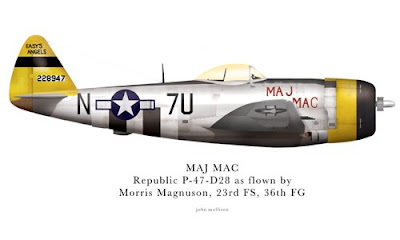
Seems like everyone has one of those Weird Stories that make a person wonder if there are unseen forces at work. My Weird Story involves the research behind this particular aircraft.
The artwork was commissioned by a businessman who knew the pilot and wanted to honor him by dedicating a large work of Jack's Hellcat at the man's hometown airport in Martinsville, Virginia (the original print is hanging there, btw).
The print was to be a surprise but there were no known photographs or references of any of the specific aircraft Jack flew in combat. The man paying my tab wanted either hard documentation and/or Jack Hankin's personal blessing that "...that Hellcat was the one he flew."
Since I interview pilots often enough, I was able to quiz Jack on vitals (markings, numbers, coloration) without arousing too much suspicion. However, Jack admitted he didn't have any photographs of any of the Hellcats he flew in combat. Like so many pilots I've interviewed, he said something similar to "If I would have known then that 60 years later, someone was going to need references on the oil stains on my windscreen..."
He then embarked on one of those rambing memory joggers - "Hmmmm. I might have a photo...no, no...hmmm....maybe I could call up so'n so...no, he wouldn't have..."
After a bit, Jack sighed and drawled, "Well, the only photo I know of me in a Hellcat is from the August 1944 issue of National Geographic."
Now it gets weird. The next day, I bump into a guy at the gym - a guy I know only casually - and I get this peculiar urge to ask him if he had any old National Geographics. Up until this point, there was nothing in our casual "Hey!" "How's it goin'?" relationship to warrant any hope that he'd be any help at all. I'm not even a mystic - skepticism runs strong in my veins - but I followed my impulse.
"Hey. Jean. You know where I can get any old National Geographics? From the World War Two?"
He looked at me a little crosseyed, stopped and replied, "Well, my mother has a couple. Not many. Maybe. What one?"
The next week, he shows up with an August 1944 edition. (insert spooky sound effects). Jean was as wide-eyed as I was after I explained the significance - he said his mom had a mere handful of NG's! Peeling open the pristine, but brittle pages, sure enough, on Color Plate "V", there was Jack on the Yorktown, idling in "22" awaiting the cue to take off!
I called Jack that day and he had a howl. We discussed markings, paint schemes and settled on the art above - the greenish nose, the larger fuselage insignia and the block "22." Of course, he thought I was documenting his plane for some article...and was blown away to see his plane at the surprise presentation held at the Martinsville airport later that Summer.
He had a lot to remember from his days on the Yorktown...
“It was just a scratch! About an inch long - it bled, but there wasn’t even enough for a single stitch!” Jack recalled, laughing. “Just a scratch. Looking at my airplane, I just couldn’t believe that I’d take a hit like that and get just a little cut. The engineers made a quick decision, grabbed the color film from the cameras and just pushed my Hellcat overboard. It wasn’t worth the time and effort to repair. I just got a scratch.”
He couldn't remember if "22" or some other Hellcat was the one pushed over, but the story of improbable events that lead through circumstance and crook to the Martinsville airport remains fascinating. I like to think that somewhere in the Pacific, "22" is sitting in the deep, blissfully unaware of the happenstance that pushed it to print.







































